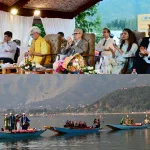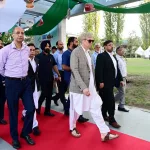POLICY TO PROGRESS
Every government has played a role and left a legacy in history. Various revolutions were brought about by different governments in power, aimed at women’s empowerment in Kashmir after independence. We cannot deny the contributions of those governments that made and shaped history. All these governments took strong steps toward empowering women and worked for their equal rights from time to time.
Several Indian governments, under their respective leaderships, continued the legacy of women’s empowerment across the country, particularly in the turbulent state of Jammu and Kashmir. However, major transformation, emancipation, and empowerment of Kashmiri women occurred under the following leaderships.
The early efforts by Prime Minister Indira Gandhi, as a woman leader for a very long period, included various initiatives toward education and social inclusion. She promoted the modernization of women’s roles through central schemes. Then, under Prime Minister Atal Bihari Vajpayee (BJP) – 1998–2004, the “Insaniyat, Jamhooriyat, and Kashmiriyat” framework was launched, promoting peace and development in J&K. He supported women’s roles in community peace-building. The expansion of Self-Help Groups (SHGs) for rural women also started gaining momentum during this time.
While going through the facts and figures related to the women of Kashmir and the leadership that took strong and concrete steps for them, through policies and schemes, and remained at the top in implementation and delivering results, it is none other than Prime Minister Narendra Modi (BJP). His period has been the most impactful and revolutionary phase for Kashmiri women.
Some of the major initiatives, policies, and schemes undertaken under his leadership have empowered Kashmiri women, especially in the post-abrogation era. These include the application of national laws protecting women’s rights (e.g., property rights, prevention of child marriage, and domestic violence laws), as well as reservation in Panchayati Raj institutions, which has significantly boosted the political participation of women.
Beti Bachao, Beti Padhao (Save the Daughter, Educate the Daughter) PM Ujjwala Yojana (LPG connections for women) PM MUDRA Yojana (financial support for women entrepreneurs) UMEED Scheme (for rural women empowerment in J&K) Women’s Police Stations and Helplines (for safety and access to justice)
Legal equality was restored after the abrogation of Article 370. Safety, justice, and dignity were prioritized through robust security and law enforcement reforms. Opportunities in education, healthcare, and entrepreneurship expanded more than ever before. This era also witnessed the emergence of female role models and leaders in politics, social sectors and economic fields.
Women in Kashmir were sufferers and victims of violence and turbulence. They did not enjoy the rights available to women in the rest of the country. Thirty-five years of prolonged violence and turmoil turned their story into one of victimhood. They were deemed unequal, incapable, and inefficient.
Misinterpretation of religious laws confined them to their homes. Central governments over the past three decades could not create a path for women to be free, to be equal members of society, to have rights, to receive justice, and to participate and contribute fully to the social structure. The restrictions imposed by religious extremists made women a burning issue, and matter of grave concern and they had no choice but to silently digest the injustice and victimhood brought by the violence of the last three decades.
The fact of the matter is that Kashmiri women saw a changing and empowering patterns established under the new government and post abrogation. Leadership at the Centre not only safeguarded and protected the rights of women but also supported the aspirations and ambitions of women in Kashmir to be empowered and uplifted.
The history of Kashmiri women has been entirely different, and it needed to be addressed differently, and this is exactly what the BJP government did. Without exaggeration, facts remain facts, and the fact is that Kashmiri women got the opportunity for transformation under the present government due to its policies and initiatives aimed at advancing women in Kashmir.
Women in Kashmir comprise 47% of the population, as per the census. Bringing half of the population onto the right track was made possible by the present government. The present government has identified five key areas that needed to be targeted: freedom and social justice, leading without following extremist groups, socio-economic development, a commitment to equality, and promoting participation and reservation in government. These targets they set to cover and make their agenda.
Today what we see is that women are at forefront at social, political and educational levels. The most significant step was the abrogation of Article 370, which not only integrated and united Kashmir but also paved the way for women’s emancipation. Existing and newly implemented schemes and policies have been accelerated more vibrantly and effectively. Systemic obstacles have been removed, allowing women to contribute towards achieving India’s vision of a Viksit Bharat (Developed India) by 2047.
Using currently available data and considering historical developments, women’s empowerment has seen significant growth in recent times due to modern, women-oriented policies that enable women to uplift themselves, which is the hallmark of true policymaking.
(The author writes specifically on Kashmiri women’s rights and issues. She is also pursuing PhD in Gender Studies. Feedback at: [email protected] )








